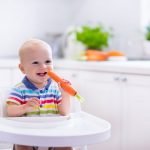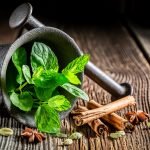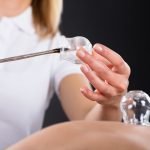Debbie Whittington, ND
Acne vulgaris is an incredibly common skin disorder in Western developed nations. More adults than ever before are being seen in physicians’ offices with adult-onset acne. In the past, acne was solely blamed on “puberty,” and teenage boys were most affected. However, with the rise in hormone-fed cows, food sensitivities, digestive problems, toxic environments, stress, high-carbohydrate diets, and mineral and vitamin deficiencies, acne plagues all ages.
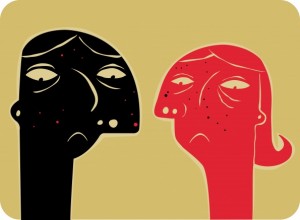
Acne is a disease of the pilosebaceous glands. Excessive sebum production, hyperkeratinization, proliferation of Propionibacterium acnes bacteria, and increased sebaceous gland sensitivity to androgens cause acne papules to develop.1,2
Each of my patients affected by acne tells me that she will “do anything” to get rid of it. Typically, those with acne seek out naturopathic treatments because they have already tried “everything” or do not want to resort to isotretinoin, antibiotics, or oral contraceptives.
Because acne can cause emotional pain and embarrassment, I address the symptom of acne as quickly as possible, while helping patients figure out what is causing the acne. A powerful nontoxic tool that I offer for the immediate treatment of acne is intense pulsed light (IPL) therapy. This modality uses green light to treat P acnes overgrowth and heat to treat the inflammation. Following is a case study of successful acne treatment using IPL and other naturopathic therapies.
Patient History
CD is a 28-year-old woman who was seen in my office with acne primarily located on her cheeks, chin, and forehead. She had more than 10 papules or pustules on each of these areas, which I consider severe acne. She had open comedones on her nose and chin and closed comedones primarily on her cheeks, chin, and forehead. In addition, she experienced painful red cysts on her cheeks and chin. She had pale skin with red undertones.
The acne worsened 1 week before her period and improved once menses begins. However, the acne never completely healed. She has had acne since she was a teenager and has managed it with moderate success using 1 year of oral tetracycline as a teen and several years of birth control. Although the birth control pills helped the acne, she experienced mood swings and depression and “didn’t want to take it anymore.” In addition, CD had tried “many” topical prescriptive medications, with no real results. Most recently, she tried isotretinoin for 1 week and had “horrible” adverse effects, including depression, joint pain, and painful flaky skin.
Currently, she was receiving weekly facials and using several topical products. These included a benzoyl peroxide spot treatment, with no noticeable effects.
CD was being treated for hypothyroidism with levothyroxine sodium and thought that it was managed well. Her menstrual cycle was 32 days long, with 3 days of light bleeding and 2 days of spotting. CD did not have cramping, headaches, or any other related symptoms around her menses. Her stress levels were moderate, and she exercised 3 to 5 times per week. Her diet was varied, and she ate dairy, sugar, and gluten daily. She complained of constipation, gas, and bloating; she would have a bowel movement daily or every other day. She was not taking any current supplements.
Treatment Plan
Acne is a multifaceted condition, so I look at the effects of hormone production, digestive health, emotional health, and toxic effects on the system. In many of my patients with acne, I will test serum levels of free testosterone and total testosterone, sex hormone–binding globulin, dehydroepiandrosterone sulfate, thyrotropin, free triiodothyronine, free thyroxin, 1,25 dihydroxyvitamin D, fasting glucose, complete blood cell count, ferritin, and IgG food sensitivities. CD did not have insurance coverage, so we opted not to do any testing.
After reading about IPL on the clinic Web site, CD wanted to begin IPL treatments immediately. She began the 8 treatments, biweekly for 4 weeks. In addition, she started a 28-day allergy elimination and detoxification diet, an acne-specific cleanser and moisturizer 2 times daily, a skin-specific multivitamin and herbal combination, vitamin D3 (2000 IU daily), omega-3 fatty acids (2000 mg), and a high-potency dairy-free probiotic (15 billion live culture blend of Lactobacillus acidophilus and Bifidobacterium animalis subsp lactis daily). The elimination diet included taking out gluten, soy, dairy, sugar, alcohol, coffee, and corn. The key ingredients in the skin-specific multivitamin and herbal combination are given in the Table.
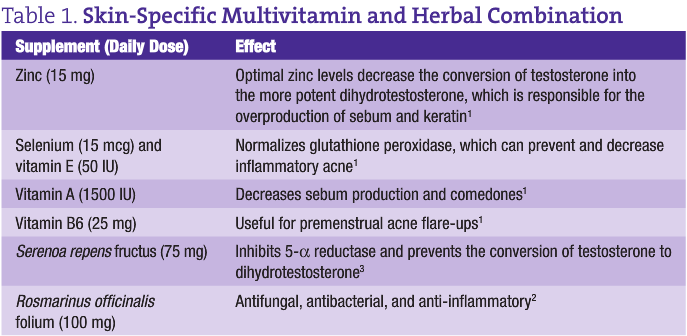
4-Week Follow-up
After 2 weeks, the constipation, gas, bloating, and pain had completely resolved. CD was still experiencing new breakouts, but they were clearing more quickly than before starting IPL therapy.
At 4 weeks, CD no longer had the deeper and painful cystic acne. She was still having new breakouts, but they were not as numerous.
We discussed reintroducing the foods that she had eliminated to help her clarify which foods may be contributing to the digestive issues and acne. She was to continue the supplement regimen.
8-Week Follow-up
CD experienced a significant decrease in acne breakouts. Her skin was 90% clearer, with 1 to 2 closed papules present on her cheeks bilaterally and her chin. Her forehead was clear of acne. She had discovered that gluten, dairy (with the exception of yogurt), and sugar caused both the digestive complaints and acne. She was satisfied with the results and would continue on the treatment plan.
1-Year Follow-up
CD returned to my office 1 year after initially starting treatment. She was having more acne breakouts and was concerned that they might get to the point they were 2 years previously. She had not been following the gluten-, sugar-, and dairy-free diet and believed that this was the likely cause of the new breakouts. In addition, she had stopped all supplements. I encouraged her to begin eliminating the foods again and to restart the probiotic, vitamin D3, and omega-3 fatty acids. CD wanted to undergo another course of 8 IPL treatments, which we started that day. Four weeks later, CD’s skin was 90% cleared, and she was ecstatic. She no longer had to wear heavy makeup concealer and was able to eat some gluten and dairy without consequence.
In Conclusion
Although acne can be challenging to treat, the naturopathic approach can offer significant change for patients with this condition. We have many tools to choose from to help patients not only cure their acne but also significantly improve their overall health. Working with patients who have acne is rewarding because they are highly motivated and are very pleased with the thorough naturopathic approach when all other treatments had failed.
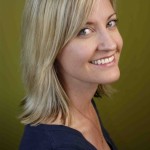 Debbie Whittington, ND, is a graduate of Bastyr University and practices in Seattle, Washington. One of Dr Whittington’s passions is working with patients who have chronic skin problems, including eczema, acne, psoriasis, rosacea, sun damage, and unwanted hair growth. As Dr Whittington tells her patients, “the skin is a reflection of a person’s overall health.” Dr Whittington works with patients to determine food sensitivities, toxin overload, hormone imbalances, and immune system dysfunction that can contribute to unwanted skin conditions. She uses intense pulsed light (IPL) therapy to treat intractable skin conditions and finds that patients undergoing the most advanced light technology feel and look better faster and longer.
Debbie Whittington, ND, is a graduate of Bastyr University and practices in Seattle, Washington. One of Dr Whittington’s passions is working with patients who have chronic skin problems, including eczema, acne, psoriasis, rosacea, sun damage, and unwanted hair growth. As Dr Whittington tells her patients, “the skin is a reflection of a person’s overall health.” Dr Whittington works with patients to determine food sensitivities, toxin overload, hormone imbalances, and immune system dysfunction that can contribute to unwanted skin conditions. She uses intense pulsed light (IPL) therapy to treat intractable skin conditions and finds that patients undergoing the most advanced light technology feel and look better faster and longer.
References
1. Pizzorno JE, Murray MT, Joiner-Bey H. The Clinician’s Handbook of Natural Medicine. New York, NY: Churchill Livingstone; 2002:1-2.
2. Yarnell E, Abascal K, Hooper C. Clinical Botanical Medicine. New York, NY: Mary Ann Liebert Inc; 2003:196, 223.
3. Tilgner S. Herbal Medicine, From the Heart of the Earth. Creswell, OR: Wise Acres Publishing; 1999:105.


